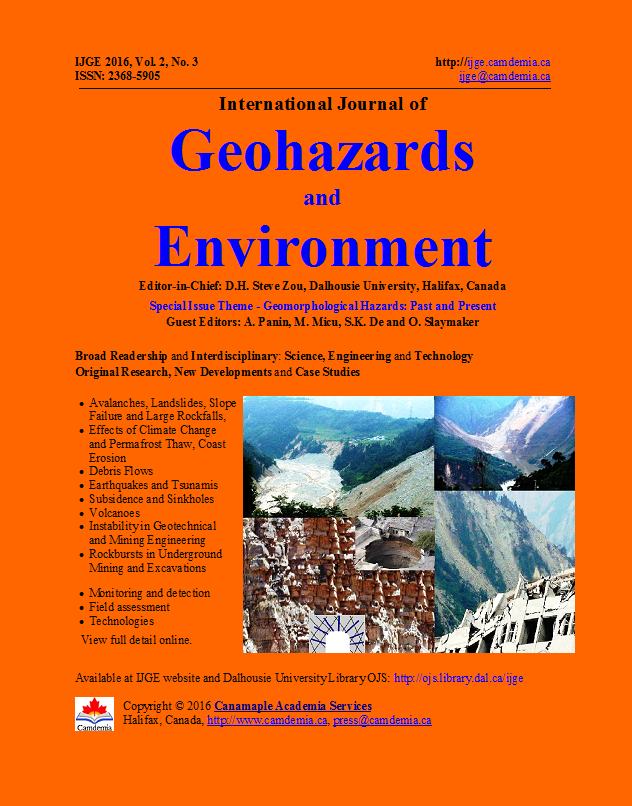Quantitative Estimations of the Holocene Erosion due to Seismically Induced Landslides in the SE Altai (Russia) Applying Detailed Profiling and Statistical Approaches
DOI:
https://doi.org/10.15273/ijge.2016.03.012Keywords:
seismicity, paleoseismogeology, earthquake-triggered landslides, erosion rate, detailed profiling, Russian Altai, HoloceneAbstract
Earthquakes are some of the most disastrous natural hazards. Coseismic slope failures often significantly contribute to the global damage and may cause most of the casualties related to strong earthquakes. Seismically induced landslides are widespread phenomena within tectonically active mountain terrain. Their abundant occurrence and the large volumes of displaced slope material reveal their great influence on topographic changes. This paper presents new correlations between the earthquake magnitude and the total volume of displaced slope material and between earthquake magnitude and the volume of the largest triggered landslide. These relationships allow us to quantify erosion due to seismically triggered landslides. Calculation of the total volume of displaced slope material is based on the parameters of the largest landslides which could be preserved in the topography for thousands years. This approach was tested in the most seismically active southeastern part of Russian Altai, which is evidenced by numerous giant earthquake-induced paleo-landslides. The total volume of slope material displaced during ancient earthquakes within the Chagan-Uzun river basin, calculated on the basis of statistical correlations, is (3.0-4.3)à—10-1 km3, and the Holocene erosion rate due to seismically induced landslides (1.1-3.0)à—10-5 m a-1. The numerical estimates were verified by calculating the volumes of all detected earthquake-triggered landslides within the Chagan-Uzun river basin and the neighboring Kurai basin on the basis of detailed profiling approach, which are 1.33à—10-1 and 2.25à—10-1 km3, respectively. The Holocene erosion rate due to seismically induced landslides in these basins could be estimated at 1.1à—10-5 and 1.4à—10-5 m a-1, respectively. Thus the Holocene erosion rate of the SE Altai due to earthquake-triggered landslides obtained by applying different techniques can be estimated at (1.1-3.0)à—10-5 m a-1, which more precisely characterizes topography changes within the Chuya-Kurai system of intermountain depressions and framing ridges.Downloads
Issue
Section
License
Copyright, Terms and Conditions
The International Journal of Geohazards and Environment (the Journal) is published by Canamaple Academia Services (the Publisher) online with open access, under a Creative Commons Attribution-Noncommercial license (CC-BY-NC) (http://creativecommons.org/licenses/by-nc/4.0/). Authors (the Authors) submitting papers (the Work) for publication in the Journal automatically agree to the following terms and conditions.
1. Under the license (CC-BY-NC), Authors give permission for others to share and reuse the Work, as long as the original source and author(s) are properly cited (i.e. a complete bibliographic citation and link to the Journal website) and the material is not used for commercial purposes. Any sharing or reuse must however indicate the original CC-BY-NC license terms of the work.
2. Authors transfer and assign to the Publisher all copyright in and to the Work. However Authors retain all proprietary rights except the copyright, related to the Work and also retain the rights a) to use, reproduce, distribute, and publicly display the Work in any medium in connection with the Authors‘ academic and professional activities, such as teaching, presentations and lectures, b) to create derivative works from the Work and to make full use of the Work in future research and publications, c) to authorize others to make any non-commercial use of the Work, d) to make both the pre-published and final-published versions available online in institutional and/or disciplinary repositories or on their own websites with a citation and link to the original paper published in the Journal.
3. Authors warrant that the Work is their original work, it is not copied from anywhere or anyone else, they are totally responsible for the authenticity, originality, validity and accuracy, and the facts and views are their own, that the Work contains no matter which is defamatory or infringes any literary or proprietary rights, intellectual property rights, or any rights of privacy, and that the Work has not been simultaneously submitted to any other journals or publishers. Authors further agree that their manuscripts whether accepted or rejected will not be returned and the rejected manuscripts will be disposed at the journal editor's discretion.
Disclaimer: The Publisher, the Journal and the editors accept no responsibility for statements or opinions expressed by authors. Use of information and materials in the Journal is the sole responsibility of users.


